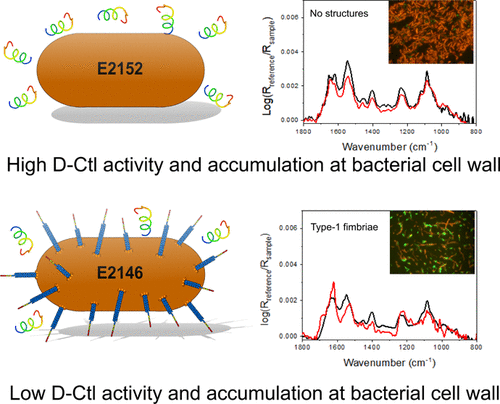当前位置:
X-MOL 学术
›
ACS Chem. Biol.
›
论文详情
Our official English website, www.x-mol.net, welcomes your
feedback! (Note: you will need to create a separate account there.)
Parietal structures of Escherichia coli can impact the D-cateslytin antibacterial activity.
ACS Chemical Biology ( IF 3.5 ) Pub Date : 2020-09-16 , DOI: 10.1021/acschembio.0c00622 Fabienne Quilès 1 , Danielle Barth 2 , Oliver Peric 3 , Georg E Fantner 3 , Grégory Francius 1
ACS Chemical Biology ( IF 3.5 ) Pub Date : 2020-09-16 , DOI: 10.1021/acschembio.0c00622 Fabienne Quilès 1 , Danielle Barth 2 , Oliver Peric 3 , Georg E Fantner 3 , Grégory Francius 1
Affiliation

|
Bacterial resistance to conventional antibiotics is of major concern. Antimicrobial peptides (AMPs) are considered excellent alternatives. Among them, D-cateslytin (D-Ctl, derivative of a host defense peptide) has shown high efficiency against a broad spectrum of bacteria. The first target of AMPs is the outer membrane of the bacterium. However, the role of bacterial cell-wall structures on D-Ctl’s mechanism of action has not yet been understood. In this study, we investigated the activity of D-Ctl on two isogenic strains of E. coli: one is devoid of any parietal structures; the other constitutively overexpresses only type 1 fimbriae. We studied the damage caused by D-Ctl at several initial concentrations of bacteria and D-Ctl, and exposure times to D-Ctl were examined using a combination of epifluorescence microscopy, atomic force microscopy (AFM), and Fourier transform infrared spectroscopy in attenuated total reflectance mode (ATR-FTIR). The analysis of nanomechanical and spectrochemical properties related to the antibacterial mechanism showed a concentration dependent activity. Whereas the membrane permeabilization was evidenced for all concentrations of D-Ctl and both mutants, no pore formation was observed. The bacterial stiffness is modified dramatically concomitantly to major membrane damage and changes in the spectral fingerprints of the bacteria. In the case of the occurrence of type 1 fimbriae only, an intracellular activity was additionally detected. Our results evidenced that D-Ctl activity is highly impacted by the cell-wall external structures and surface properties of the bacteria.
中文翻译:

大肠杆菌的壁结构可影响D-cateslytin的抗菌活性。
对常规抗生素的细菌耐药性是主要关注的问题。抗菌肽(AMPs)被认为是极好的替代品。其中,D-cateslytin(D-Ctl,宿主防御肽的衍生物)对广谱细菌显示出高效率。AMPs的第一个靶标是细菌的外膜。然而,细菌细胞壁结构对D-Ctl的作用机理的作用尚未被了解。在这项研究中,我们研究了D-Ctl在两种大肠杆菌同基因菌株上的活性:一种没有任何顶叶结构;另一种没有任何壁结构。另一个在组成型上仅过表达1型菌毛。我们研究了在几个初始浓度的细菌和D-Ctl下由D-Ctl造成的损害,并使用落射荧光显微镜,原子力显微镜(AFM)和傅里叶变换红外光谱结合在衰减中检测了D-Ctl的暴露时间。全反射率模式(ATR-FTIR)。与抗菌机理有关的纳米力学和光谱化学性质的分析显示出浓度依赖性活性。尽管对于所有浓度的D-Ctl和两个突变体都证明了膜的透化作用,但是没有观察到孔的形成。细菌的刚度显着地伴随着主要的膜损伤和细菌的光谱指纹的改变而大大地改变。在发生1型菌毛的情况下仅,另外检测到细胞内活性。我们的结果证明,D-Ctl活性受到细菌的细胞壁外部结构和表面特性的极大影响。
更新日期:2020-10-17
中文翻译:

大肠杆菌的壁结构可影响D-cateslytin的抗菌活性。
对常规抗生素的细菌耐药性是主要关注的问题。抗菌肽(AMPs)被认为是极好的替代品。其中,D-cateslytin(D-Ctl,宿主防御肽的衍生物)对广谱细菌显示出高效率。AMPs的第一个靶标是细菌的外膜。然而,细菌细胞壁结构对D-Ctl的作用机理的作用尚未被了解。在这项研究中,我们研究了D-Ctl在两种大肠杆菌同基因菌株上的活性:一种没有任何顶叶结构;另一种没有任何壁结构。另一个在组成型上仅过表达1型菌毛。我们研究了在几个初始浓度的细菌和D-Ctl下由D-Ctl造成的损害,并使用落射荧光显微镜,原子力显微镜(AFM)和傅里叶变换红外光谱结合在衰减中检测了D-Ctl的暴露时间。全反射率模式(ATR-FTIR)。与抗菌机理有关的纳米力学和光谱化学性质的分析显示出浓度依赖性活性。尽管对于所有浓度的D-Ctl和两个突变体都证明了膜的透化作用,但是没有观察到孔的形成。细菌的刚度显着地伴随着主要的膜损伤和细菌的光谱指纹的改变而大大地改变。在发生1型菌毛的情况下仅,另外检测到细胞内活性。我们的结果证明,D-Ctl活性受到细菌的细胞壁外部结构和表面特性的极大影响。











































 京公网安备 11010802027423号
京公网安备 11010802027423号